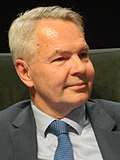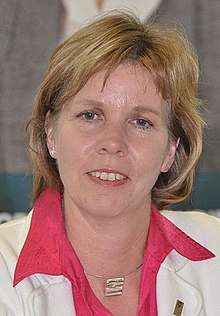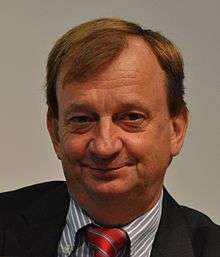2019 Finnish parliamentary election
Parliamentary elections were held in Finland on 14 April 2019.[5] For the first time, no party received more than 20% of the vote. The Centre Party, which had been the largest party following the 2015 elections lost 18 seats as it recorded its lowest vote share since 1917 and dropped to fourth place, with the Social Democratic Party seeing the biggest gains, winning an additional six seats and narrowly becoming the largest party. The Green League and the Left Alliance also gained five and four seats respectively.
| |||||||||||||||||||||||||||||||||||||||||||||||||||||||||||||||||||||||||||||||||||||||||||||||||||||||||||||||||||||||||||||||||||||||||||||
All 200 seats in Parliament 101 seats needed for a majority | |||||||||||||||||||||||||||||||||||||||||||||||||||||||||||||||||||||||||||||||||||||||||||||||||||||||||||||||||||||||||||||||||||||||||||||
|---|---|---|---|---|---|---|---|---|---|---|---|---|---|---|---|---|---|---|---|---|---|---|---|---|---|---|---|---|---|---|---|---|---|---|---|---|---|---|---|---|---|---|---|---|---|---|---|---|---|---|---|---|---|---|---|---|---|---|---|---|---|---|---|---|---|---|---|---|---|---|---|---|---|---|---|---|---|---|---|---|---|---|---|---|---|---|---|---|---|---|---|---|---|---|---|---|---|---|---|---|---|---|---|---|---|---|---|---|---|---|---|---|---|---|---|---|---|---|---|---|---|---|---|---|---|---|---|---|---|---|---|---|---|---|---|---|---|---|---|---|---|
| Turnout | 72.84% | ||||||||||||||||||||||||||||||||||||||||||||||||||||||||||||||||||||||||||||||||||||||||||||||||||||||||||||||||||||||||||||||||||||||||||||
| |||||||||||||||||||||||||||||||||||||||||||||||||||||||||||||||||||||||||||||||||||||||||||||||||||||||||||||||||||||||||||||||||||||||||||||
| |||||||||||||||||||||||||||||||||||||||||||||||||||||||||||||||||||||||||||||||||||||||||||||||||||||||||||||||||||||||||||||||||||||||||||||
The Finns Party and the National Coalition Party also gained one seat each, with the Finns Party recovering the seats it had lost in the previous parliament when 21 of its MPs left to form Blue Reform, which failed to win a seat. The Swedish People's Party and the Christian Democrats retained all of their seats that they had won in the previous elections. The Åland Coalition retained their seat in the Åland Islands, whilst Harry Harkimo, a former National Coalition MP who founded Movement Now twelve months earlier, was reelected in his constituency, thus giving his own movement its first elected MP.
Social Democratic Party leader Antti Rinne subsequently formed a coalition government with the Centre Party, Green League, Left Alliance and Swedish People's Party. Due to the Centre Party's devastating defeat, Prime Minister Juha Sipilä consequently announced that he would continue as the chairman only until the party's next convention in September 2019.[6]
Background
The incumbent government was formed by a three party center-right coalition, composed of the Centre Party, Finns Party and National Coalition Party.[7] On 28 May 2015, the parliament elected Juha Sipilä as prime minister by a vote of 128–62.[8]
2017 government crisis
On 10 June 2017, the Finns Party elected Jussi Halla-aho as the new leader of the party, after the long-time leader Timo Soini had decided to step down. Following the talks among the three coalition leaders, Sipilä and Minister of Finance Petteri Orpo announced that they would no longer cooperate in a coalition government with the Finns Party. The collapse of government was averted on 13 June when twenty MPs defected from the Finns Party's parliamentary group, forming what would eventually become the Blue Reform party. One MP (Kike Elomaa) later returned to the Finns Party and another (Kaj Turunen) defected to National Coalition Party, leaving the Blue Reform with 18 and Finns Party with 17 MPs. Veera Ruoho furthermore defected to the National Coalition. Sipilä's government retained a majority in the Parliament as the Blue Reform continued as a member of the coalition and the Finns Party was moved to the opposition.[9]
On 8 March 2019, prime minister Sipilä resigned. However, that same day president Sauli Niinistö reappointed him as head of a caretaker government. According to Sipilä, his government collapsed because of the failure to reach agreement on the controversial health care reform. But several Finnish political analysts (Thomas Karv, Teivo Teivainen) interpreted his resignation as a strategic move that could give the coalition parties, Sipilä's Centre Party in particular, more freedom during the election campaign. Thus, the Centre Party might be able to revive itself in the polls, in which the party was lagging behind the Social Democrats.[10]
Campaign
After the Oulu child sexual exploitation scandal, support for the anti-immigration Finns Party surged from around 8.5% to 9% in late 2018 to 17.5% by the election.
The Social Democrats proposed raising taxes to fund the country's generous welfare system.[11]
The election saw "an unusual level of aggression on the campaign trail"[12] considering "attacks on politicians are rare in Finland".[13] In late March, a man struck Left Alliance candidate Suldaan Said Ahmed in the chest while calling him an infidel and pedophile[14] a day after a man wearing logos of far-right anti-immigrant group Soldiers of Odin attempted to attack Foreign Minister Timo Soini of the Blue Party.[13]
Electoral system
The 200 members of the Eduskunta were elected using proportional representation in 13 multi-member constituencies, with seats allocated according to the D'Hondt method. The number of elected representatives is proportional to the population in the district six months prior to the elections. Åland has single member electoral district and its own party system.[15] Compared to the last election in 2015, one seat has been reallocated from Savonia-Karelia to Uusimaa.
| Electoral district | Seats |  |
|---|---|---|
| 01 Helsinki | 22 | |
| 02 Uusimaa | 36 | |
| 03 Finland Proper | 17 | |
| 04 Satakunta | 8 | |
| 05 Åland | 1 | |
| 06 Tavastia | 14 | |
| 07 Pirkanmaa | 19 | |
| 08 South-East Finland | 17 | |
| 09 Savonia-Karelia | 15 | |
| 10 Vaasa | 16 | |
| 11 Central Finland | 10 | |
| 12 Oulu | 18 | |
| 13 Lapland | 7 |
Opinion polls
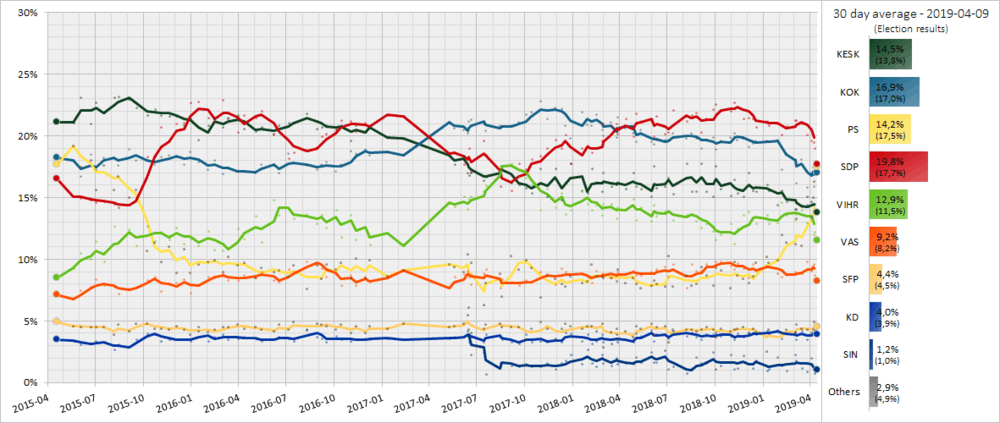
Results
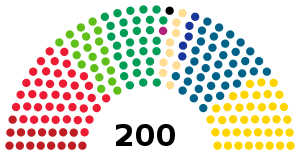 | |||||
| Party | Votes | % | Seats | +/– | |
|---|---|---|---|---|---|
| Social Democratic Party | 546,471 | 17.73 | 40 | +6 | |
| Finns Party | 538,805 | 17.48 | 39 | +1 | |
| National Coalition Party | 523,957 | 17.00 | 38 | +1 | |
| Centre Party | 423,920 | 13.76 | 31 | –18 | |
| Green League | 354,194 | 11.49 | 20 | +5 | |
| Left Alliance | 251,808 | 8.17 | 16 | +4 | |
| Swedish People's Party | 139,640 | 4.53 | 9 | 0 | |
| Christian Democrats | 120,144 | 3.90 | 5 | 0 | |
| Movement Now | 69,427 | 2.25 | 1 | New | |
| Blue Reform | 29,943 | 0.97 | 0 | New | |
| Pirate Party | 19,032 | 0.62 | 0 | 0 | |
| Åland Coalition | 11,640 | 0.38 | 1 | 0 | |
| Seven Star Movement | 11,366 | 0.37 | 0 | New | |
| Citizens' Party | 7,645 | 0.25 | 0 | New | |
| Feminist Party | 6,662 | 0.22 | 0 | New | |
| Liberal Party – Freedom to Choose | 5,014 | 0.16 | 0 | New | |
| Communist Party | 4,305 | 0.14 | 0 | 0 | |
| Animal Justice Party | 3,378 | 0.11 | 0 | New | |
| Independence Party | 2,444 | 0.08 | 0 | 0 | |
| Finnish People First | 2,366 | 0.08 | 0 | New | |
| Communist Workers' Party – For Peace and Socialism | 1,240 | 0.04 | 0 | 0 | |
| Aito suomalainen yhteislista | 589 | 0.02 | 0 | New | |
| Reform List | 525 | 0.02 | 0 | New | |
| Alternative for Åland | 358 | 0.01 | 0 | ||
| Rehtiliike yhteislista | 344 | 0.01 | 0 | New | |
| Yhteislista Jaana ja Leo | 87 | 0.00 | 0 | New | |
| Independents | 6,612 | 0.21 | 0 | – | |
| Total | 3,081,916 | 100.00 | 200 | 0 | |
| Valid votes | 3,081,916 | 99.42 | |||
| Invalid/blank votes | 17,844 | 0.58 | |||
| Total votes cast | 3,099,760 | 100.00 | |||
| Registered voters/turnout | 4,510,040 | 68.73 | |||
| Source: Vaalit | |||||
Government formation
During election debates, the Social Democrats, the National Coalition Party, Green League, Left Alliance, and the Swedish People's Party stated that they were interested in joining a coalition that does not include the Finns Party.[16] Despite being ruled-out by five parties, Finns Party chairman Jussi Halla-aho said that all parties should show responsibility when forming a coalition. He said the most responsible way to form a coalition is to include the Finns Party.[16]
Two weeks later, SDP chairman Antti Rinne, who was expected to lead the government, sent a questionnaire to each of the other parties, to assess their positions on various topics such as basic income, collective bargaining, climate change or health care reform.[17] Based on the answers and initial talks with all parties, Rinne announced that he would negotiate forming a government with Centre Party, Green League, Left Alliance and Swedish People's Party.[18] The negotiations were ultimately successful, and the Rinne Cabinet was formally inaugurated on 6 June.[19]
References
- "Nyt se ratkesi – Stubb sivuun, Petteri Orpo on kokoomuksen uusi puheenjohtaja". Ilta-sanomat. 11 June 2016. Retrieved 11 June 2016.
- "Li Andersson kruunattiin virallisesti puheenjohtajaksi". Iltalehti. 2016-06-11. Retrieved 2016-06-11.
- "Anna-Maja Henriksson valittiin Rkp:n puheenjohtajaksi – "Me teimme sen. Me rikoimme lasikaton!"". Helsingin sanomat. 12 June 2016. Retrieved 12 June 2016.
- "Kristillisdemokraattien uusi puheenjohtaja on Sari Essayah – haluaa malliksi Saksan sisarpuolue CDU:n". Helsingin Sanomat. 28 August 2015. Retrieved 29 August 2015.
- Upcoming Elections 2015-2030 Archived 2018-03-21 at the Wayback Machine, Vaalit.fi, accessed 3 June 2015.
- "Juha Sipilä jättää puheenjohtajan tehtävät, ei halua tulla tänään median eteen – Katso, miten puoluesihteeri kommentoi Sipilän eroa" (in Finnish). Yle. 16 April 2019. Retrieved 16 April 2019.
- Sipilä opts for right-leaning government, YLE News 7 May 2015, accessed 3 June 2015.
- "Juha Sipilä valittiin äänin 128-62 pääministeriksi". Verkkouutiset. 2016-05-28. Retrieved 2016-03-03.
- "Hallituskriisi raukesi perussuomalaisten jakautumiseen: monivaiheinen politiikan superpäivä kerrattuna". Yle News. 13 June 2017. Retrieved 28 June 2017.
- "Finland's Juha Sipilä Hopes to Turn Crisis into Election Reboot". Politico Europe. 10 March 2019. Retrieved 12 March 2019.
- https://news.yahoo.com/finlands-top-candidate-prime-minister-says-wants-raise-075456854--business.html
- "Scuffles, suspected assault at Helsinki election event". Yleisradio Oy. April 13, 2019. Retrieved April 15, 2019.
- "Attempted street attack on Foreign Minister Timo Soini". Yleisradio Oy. March 24, 2019. Retrieved April 15, 2019.
- "Police probe attack on foreign-background election candidate in Helsinki". Yleisradio Oy. March 25, 2019. Retrieved April 15, 2019.
- Electoral Districts Archived 2015-06-03 at the Wayback Machine, Vaalit.fi, accessed 3 June 2015.
- "Five party leaders reject idea of forming ruling coalition with Finns Party". helsinkitimes.fi. 2019.
- "SDP highlights economy, equality and education in search for govt partners". yle.fi. 26 April 2019.
- "Näin syntyi hallitusohjelmasta neuvotteleva uusi punamulta". Yle. 8 May 2019. Retrieved 9 May 2019.
- "Finland's new government: SDP, Centre dominate ministerial portfolios". yle. 3 June 2019. Retrieved 4 June 2019.
Further reading
- Arter, David (2020). "When a pariah party exploits its demonised status: the 2019 Finnish general election". West European Politics. 43: 260–273. doi:10.1080/01402382.2019.1635799. ISSN 0140-2382.
- Special issue of Scandinavian Political Studies on the 2019 Finnish parliamentary election, Volume 42, Issue 3-4, 165-307, September‐December 2019
_(cropped).jpg)
.jpg)
_(cropped).jpg)
